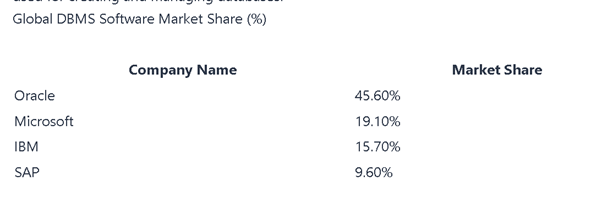Is SQL still being used for Relational Database?
The answer is yes; why? Before we explain further, we will tell you more about Relational Database and SQL so that we can properly explain the relationship between SQL and Relational Database, including the proof of whether SQL program language is still being used by everyone worldwide and in the work environment.
Relational Database is a collection of related data that stores and provides access to data points. This associated data is organized into columns and rows. Table columns contain data attributes, and each record usually has a value for each attribute, making it easy to establish relationships between data points. Each row in the table is a record with a unique ID called a key. Tables are used to store information about the objects to be represented in the database. This relational database was first initiated by an expert named EF Codd in 1970.
In a Relational Database, a key has a very important role in database design. The key is called the Relational Key. A relational key is one or more combined attributes uniquely distinguishing data rows or columns in a table. The key is:
- Superkey, an attribute that can uniquely distinguish data rows in a table. For example, in the student table, student names can be the same for (name, name), but their ids cannot be the same. Hence, this combination can also be a lock.
- Foreign Key, an attribute used to link one table to another and as a cross-reference between two tables because it references the primary key.
- Candidate Key, an attribute that identifies tuples in a table. The candidate key is a super key without repeating. Therefore, if there is a combination of 3 fields, a variety of 2 fields, and only one field, then only one field deserves to be a candidate key.
- Primary Key is the attribute used to define all records in the table. This attribute’s value cannot be Null.
There are also several types of binary relationships in a Database, which are:
- One to One (1 to 1)
- One to Many (1 to n)
- Many to Many (n to n)
Next is SQL or Standard Query Language, a language used to access, modify, and manipulate data on a relational basis or Relational Database. The computer language in this relational database is based on standards issued by the American National Standards Institute (ANSI). SQL standardization has existed since 1986 and was indeed initiated by ANSI. Until now, many servers in a database or software could interpret the SQL language. Therefore, SQL is a subject of discussion and material that is very important for those of you who are involved in IT and related to relational databases.
The existence of SQL in managing a database provides its function. For an admin, having SQL can allow you to access or modify the database. SQL can also be used to delete data from a database. Another function of SQL is to create a new procedure that will be stored in a database. Besides that, you can also set access rights in tables, policies, and other important things. So, SQL is a special language used when creating or processing databases, especially Relational databases on a website.
Then here we will discuss whether SQL is still being used as the language for the Relational Database in the workplace today, especially since many elements need to be assigned in Relational Databases like the key, then also the cardinality, or we can say, the type of Relational Database needs to be given with SQL language. The answer is yes; even today from 1970, it’s still being developed, showing more and more newer versions of SQL applications, and is still being used by the company or businesses for managing high amounts of data in SQL Server with nine application Microsoft Access(Microsoft SQL Server), Oracle, Ms. SQL Server, MySQL, Firebird, Postgre SQL, Teradata, IBM DB2, and Informix.
These nine main Relational Databases applications use SQL as the programming language. In short, today, SQL is still being used for Relational Databases. Even other types of Database SQL still have a few advantages toward tableless databases, like fixed server maintenance; of course, this becomes more favorable for the business to manage their finances.
The proof is

Image source:https://accounting-area.com/qa/how-sql-is-used-in-companies.html
The company that uses SQL from the report is 5722 companies, including Uber, Airbnb, and Shopify, which use SQL for Relational Database that supports their business more easily data processing.
This concludes that even today, SQL is still being used for Relational Databases because the database needs a language to control since it will be more efficient to control it with program language than manually. The language is still SQL because SQL is already the best language for Relational Databases. After all, it is easy to comprehend. Even today, it is still improved in the application to support SQL implementation.
Reference:
1. Sutiono S.Kom., M.Kom., M.T.I. (2017, January 17). 6 Macam Software Database dan Fungsinya. DosenIT.com. Retrieved November 14, 2022, from https://dosenit.com/kuliah-it/database/macam-macam-software-database
2. Wesley, D. (2022, May 14). Is SQL Still Relevant? — srgsoftware.io. SRG Software. Retrieved November 15, 2022, from https://www.srgsoftware.io/blog/is-sql-still-relevant
3. Simmon, G. (2012, October 29). Losing Paradise. YouTube. Retrieved November 16, 2022, from https://accounting-area.com/qa/how-sql-is-used-in-companies.html
4. Teach Computer Science. (n.d.). Relational databases & SQL | Model, How They Work, Benefits. Teach Computer Science. Retrieved November 16, 2022, from https://teachcomputerscience.com/relational-databases-and-sql/
5. Atzeni, P., & De Antonellis, V. (1993). Relational database theory. Benjamin-Cummings Publishing Co., Inc.
Keyword: SQL, Relational Database, Relationship

